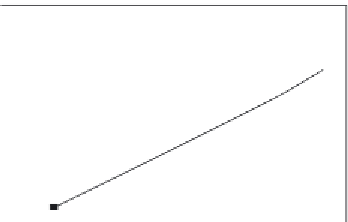Biomedical Engineering Reference
In-Depth Information
on the biosensor chip surface changes, the binding rate coefficient too exhibits a change in
the same direction. For example, as the fractal dimension decreases by a factor of 3.936 from
a value of
D
f1
equal to 2.6382 to
D
f2
equal to 0.6702, the binding rate coefficient decreases
by a factor of 58.91 from a value of
k
1
equal to 12.135 to
k
2
equal to 0.2060. Similarly, as the
fractal dimension increases by a factor of 3.936 from a value of
D
f2
equal to 0.6702 to
D
f3
equal to 1.3642, the binding rate coefficient increases by a factor of 6.86 from a value of
k
2
equal to 0.2060 to
k
3
equal to 1.4139.
Figure 14.2a
and
Table 14.1
show the increase in the binding rate coefficient,
k
1
, with an
increase in the fractal dimension,
D
f1
, for a dual-fractal analysis. For the data shown in
Figure 14.2a
, the binding rate coefficient,
k
1
, is given by:
D
3
:
225
0
:
7731
k
1
¼ð
0
:
6169
0
:
1007
Þ
ð
14
:
4a
Þ
f1
The fit is reasonable. Only four data points are available. The availability of more data points
would lead to a more reliable fit. The binding rate coefficient,
k
1
, is very sensitive to the
18
4
16
3
14
12
2
10
1
8
6
0
2
2.1
2.2 2.3
Fractal dimension,
D
f1
2.4
2.5
2.6
2.7
0
0.2
0.4
0.6 0.8
D
f2
or
D
f3
1
1.2
1.4
1.6
A
B
0.06
0.05
0.04
0.03
0.02
0.01
0
0
0.05
0.1
0.15 0.2
D
f2
/
D
f1
0.25
0.3
0.35
C
Figure 14.2
(a) Increase in the binding rate coefficient, k
1
, with an increase in the fractal dimension, D
f1
.
(b) Increase in the binding rate coefficient, k
2
or k
3
, with an increase in the fractal dimension, D
f2
or D
f3
. (c) Increase in the ratio k
2
/k
1
with an increase in the ratio D
f2
/D
f1
.






























































































